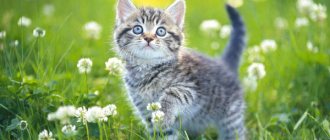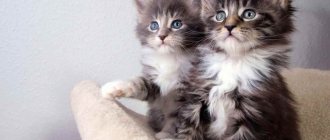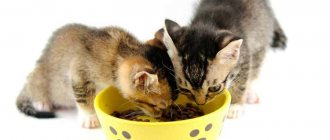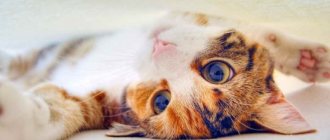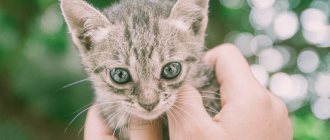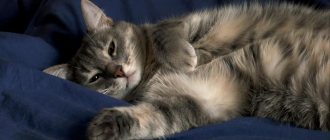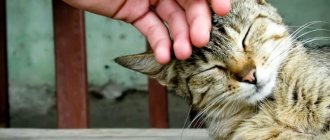Factors influencing puberty
Males and cats reach sexual maturity at different ages. Puberty in males occurs later than in male cats, which matures along with the first estrus, which begins at 5-6 months. But the timing of puberty may vary. This depends on certain factors:
- Belonging to the breed. Representatives of oriental breeds: Siamese, Thais, Orientals, Burmese and St. Petersburg Sphynxes belong to the category of early maturity.
- Skeletal structure. Cats and cats of graceful build with thin bones enter puberty earlier than their powerful counterparts.
- Seasons. Kittens born in winter or spring enter sexual maturity in spring or summer, while later litters have delayed sexual maturity.
- Conditions of detention. Compliance with the regimen and quality of feeding, as well as comfort and convenience, accelerates the maturation of the pet.
- Features of the habitat. Surrounded by adults (in a nursery or pride), young felines mature earlier than their peers from city apartments.
- Genetic predisposition.
If the pet is overfed and overweight, puberty in cats is delayed and can occur by one and a half or two years.
Features of growth of large breeds
There are several artificially bred cat breeds, the representatives of which are particularly large in size. The most common of them are the following:
- Maine Coons;
- Bengal breed;
- British breed.
Let's look at the age at which large breed cats grow, and what size they can reach with good care.
Bengal breed
Kittens are born very small, their weight does not exceed 120 grams. During the first month of life, kittens gain weight up to 500 grams. Then active development stops, and by the age of 3 months the weight is a little more than one kilogram. At 7 months the process slows down even more, but continues to progress. Animals gain the bulk of kilograms in the first two years of their existence. Regular cats weigh 7-8 kg at 5 years old, while castrated cats can reach 10 kg.
Maine Coons
The weight of a newborn Maine Coon can be 170 grams. By gaining 10 grams in weight every day, a kitten aged 10 days becomes 2 times heavier, by 28 days - 4 times heavier, and by 8 weeks - 8 times heavier. At the age of 4-5 months, the kitten's peak growth activity occurs. At this time, its energy costs are greatest. Bone growth continues for up to 1.5 years, after which muscle mass develops and the animal grows in breadth. A cat reaches its peak of development at the age of 3-5 years. At this time, his weight can increase to 10 kg.
British
Newborn kittens can weigh up to 140 grams. They grow quickly and become sexually mature by 9 months. Up to 2.5 years, bone growth occurs, and then the animal increases in width, building up muscles. General development ends by 3 years. At this time, British cats can reach 10 kg (while, for example, Scottish cats - only 6 kg). But indicators of growth and development may have individual characteristics.
Rarely do families today live without pets, and cats are the most popular among them.
Many owners of cats of various breeds are interested in what age cats grow up to.
and what influences their development.
If you observe a kitten over a long period of time, you will notice that when it reaches the age of two years, the size of its muzzle and the width of its shoulders remain unchanged. This means that formation has completed and it is no longer growing.
First of all, a kitten’s growth is influenced by its genetics:
- The main factor is the breed of the animal. The larger it is, the more time passes before the end of growth;
- hormonal background and genetic predisposition;
- A mother cat's weight also affects how quickly her babies grow. The larger it is, the sooner the kittens will grow up;
- When using hormonal drugs, an imbalance of the endocrine system develops, which negatively affects growth.
Impact of environmental factors:
- if the kitten is not eating well, its growth time changes;
- the formation is influenced by the state of the place in which the animal is located;
- if pets are often stressed, their growth is impaired;
- if the pet was neutered late, this affects not only its weight, but also its height.
Manifestations of puberty
Behavior at the onset of puberty varies between male and female cats. In females, this period is accompanied by discharge from the genitals - estrus. External signs of approaching heat are manifested in an increased desire to caress, rub against legs and furniture, and when it comes, the cat’s behavior becomes more defiant: it begins to meow invitingly, rolls on the floor, moves its tail to the side, demonstrating sexual desire.
Puberty in cats is accompanied by more aggressive behavior. The mustachioed one begins to meow loudly, attracting females, marking territory, and its urine during this period has a sharp, unpleasant odor. The cat’s character also changes - he can tear off furniture and walls, show increased playfulness, and his games are similar to scenes of hunting prey.
With the onset of puberty of the animal, the owner must decide whether he wants offspring or not. If the owner is focused on breeding cats, then he needs to find out whether the pet has breeding value and select a candidate for mating. All events can be held in clubs for cat lovers or take advice from a trusted nursery or an experienced breeder. It should also be understood that puberty and physiological maturity of a pet differ in timing: the latter occurs closer to one year of age.
If no one is going to breed a female cat, then castration or sterilization will be the right decision. This will be more humane to the animal and safer than drug regulation of sexual heat.
The best time for mating
Everyone has heard how the March cats begin to sing with the beginning of spring, but not everyone thinks about why this happens. But the fact is that March is the best time for conceiving future offspring and it is at this time that sex hormones begin to rage, because the whole summer and autumn are ahead for successful feeding of babies: the weather is warm, you don’t need to go far for food and leave the cubs unattended for a long time. Although in city conditions, March cats can continue to sing both in summer and autumn, because the basements are warm and cozy, and there is enough food in the garbage chutes to survive.
The intensity and volume of cats' screams during the mating period directly depends on the number of rivals in a given territory. The more competitors, the more heart-rendingly the mustachios meow, hiss and growl, proving their superiority over the ladies and trying to win territory from their rivals. Such duels can continue for days, which cannot but irritate apartment dwellers. And when the cats find their cats and can satisfy the need for mating, the screaming stops.
At what age do cats stop playing?
At the age of 1.5 to 2 months, kittens spend most of their time playing, interrupting only for food and sleep. The greatest activity usually occurs between 6 and 7 months of age. They may even appear hyperactive during this time.
On average, kittens play for up to a year. But this does not mean that the cat will refuse to play for the rest of its life. The most important thing is to provide conditions for the mental and physical activity of pets. For example, toys, intellectual games, scratching posts and, of course, your attention.
Causes of cat screams
At home, cats do not have the opportunity to mate freely and there is an accumulation of testosterone (male sex hormone), the excess of which leads to rutting - the cat yells at night, becomes aggressive, marks corners and desperately tries to find a cat to mate with, which is why it screams, not allowing peace for the owners.
If a cat and a cat live in the same apartment, have reached childbearing age and can mate, or the cat is spayed and the cat is neutered, and the night cries continue, then the owners should visit a veterinarian. Cat howls can be caused by hepatic or renal colic, which is accompanied by urolithiasis. The development of the disease is facilitated by an unbalanced diet, which results in the formation of stones in the genitourinary canals. And when an adult cat goes to the litter box to relieve itself, it feels a sharp cutting pain and begins to scream heart-rendingly.
Creating favorable conditions for the growth and development of a kitten
If we abstract from reference to certain breeds, then the rules for raising kittens are the same for everyone. They have a direct impact on the development of the animal and can both contribute to the transformation of a kitten into a beautiful animal, and vice versa, if they are neglected, have sad consequences, including death.
Nutrition
Nutrition is the most important aspect of kitten care. This is how the baby gets all the necessary substances. Lack of food and its inferiority lead to a slowdown in the growth and overall development of the pet. Nutrition should be age appropriate and balanced. If a kitten grows up on a natural diet, then in addition it is necessary to take vitamins and microelements.
Water mode
Water is essential in the development of all living things. Lack of water leads to dehydration. The situation could become critical. Don't assume that breastfed kittens are getting enough fluids. It is not uncommon for small kittens in a litter to become dehydrated because they received less milk. This led not only to a slowdown in development, but also to death.
Activity
Activity is a powerful element in a kitten's development. Strengthens the skeleton and ligaments. The cartilaginous bones of babies ossify faster and begin to grow. Strong ligaments help babies run and jump a lot. The skeleton is less likely to be injured during play, which means the kitten develops fully and in a timely manner.
Outdoor games are a powerful factor in a kitten’s development.
No stress
The absence of stress leads to the coordinated functioning of the endocrine system, which directly affects the growth of kittens. The absence of failures allows the production of sex hormones, on which the size of the adult individual depends, to begin in a timely manner.
Timely examination by a veterinarian
The elimination of diseases, prevention of parasites and other health problems is the merit of a good owner and breeder. Responsible people do not consider it difficult to consult with specialists once again. This means they have every chance of getting a magnificent animal in a couple of years.
Ways to Prevent Cat Crying
If the cat is healthy and lives alone in the apartment, then you can prevent cat screams by following the advice of experienced breeders:
- castrate your pet - in the absence of testicles, testosterone is not produced, which means there is no sexual desire;
- breed a cat with a cat;
- give your pet more physical activity;
- not allowing you to sleep during the day - this suppresses the instincts of a nocturnal predator;
- arrange active games with the cat so that he sleeps at night like a baby;
- monitor your pet’s diet - the cat should receive selected foods and meat so as not to feel a deficiency of nutrients. The mustachioed man begins to become lazy, and his hunting instincts become dull.
Some cats are talking breeds and will demand communication. You should not ignore such conversations, and then the animal will be calmer and more satisfied. If the option of obtaining offspring is being considered, then you should get a mate for your pet. A cat and a cat in the same apartment will not let each other get bored and will save the owner from heart-rending screams during the festivities.
If reproduction is not part of the owner’s plans, then you need to think about castration.
When and how to switch a kitten to adult food?
When you purchase a kitten from a responsible breeder, many issues with feeding bypass you. As a rule, the pet is already 3 months old and can feed itself. Depending on the type of feeding chosen, he eats either ready-made food or natural products. If you are satisfied with what the breeder fed the kitten, you just continue to stick to the diet. If you want to change food or change the type of feeding, do it gradually, after the kitten adapts to its new home. In the first days after the move, you can feed him only the usual food, i.e. exactly as the breeder gave him. Even if you don't really like this choice.
A kitten's proper diet contains increased amounts of fat and protein. High nutritional value is vital for the harmonious development of the body. The baby is growing by leaps and bounds. He has a very fast metabolism, and only a special diet can keep up with his needs. On a poor, unbalanced or inappropriate diet, kittens grow weak, lethargic and sickly.
This is why prepared foods are more popular than natural products. It is almost impossible to achieve an ideal balance of components, and with a natural type of feeding there is a high risk that the kitten does not receive all the nutrients it needs. Ready-made food, on the contrary, is completely adapted to the needs of the pet. The only thing: you need to choose good, high-quality food (super premium class).
When to switch a kitten to an adult diet?
The kitten grows and develops throughout the first year of life. At about a year, growth is complete and the kitten turns into a stately adult cat. Not only his appearance changes, but also his behavior and needs.
At 1 year of age, the cat no longer needs highly nutritious kitten food. She needs to be switched to an adult diet, with a moderate amount of fat and protein.
If this is not done, the pet will become overweight and have problems with the musculoskeletal system.
How to switch a kitten to adult food?
Any changes in the diet should occur smoothly and gradually, otherwise the body will be subject to severe stress.
Adult food is introduced into the diet gradually, in limited quantities. You continue to give your pet kitten food and gradually dilute it with adult food. Dry foods can be mixed directly in one bowl (70% kitten food and 30% adult food to start with). This won’t work with wet ones: it’s better to alternate between canned food for kittens and canned food for adults. Gradually the ratio changes in favor of the adult diet until it reaches 100%.
If you adhere to a natural type of feeding, changes in the diet should be agreed with a veterinarian. He will tell you which foods to focus on when feeding an adult cat.
Which food to choose?
Food for kittens is prescribed from 1 to 12 months of life. As soon as the cat turns one year old, she is switched to a balanced diet for adult cats.
It is advisable to choose lines from one brand. For example, if your pet has been eating Monge Kitten food, then when it reaches a year, it is better to switch it to Monge Adult Cat food (or another line of the same brand).
The compositions of feeds from different manufacturers can differ greatly, while the formulations of one brand are well combined and easily digestible. The same applies to combining dry and wet food in one diet: it is better that they are from the same brand.
Choose super premium diets. Their composition is based on selected meat. This corresponds to the natural needs of the cat, because she is primarily a predator! Super premium food is made from high-quality, safe ingredients that are perfectly balanced. The cat does not require additional vitamins and minerals with this feeding.
Before purchasing, carefully study the food packaging. Check the composition, purpose, expiration date and integrity of the packaging. To achieve results, be sure to follow the feeding rate (it is also indicated on the package) and do not mix ready-made and natural products in the same diet.
Even the best quality diet will not benefit your cat if you feed it sausages and condensed milk!
Feed your cat correctly, and its health will thank you!
Castration and indications for surgery
Castrating a cat means depriving it of its gonads, that is, completely removing the testicles through surgery. Together with the gonads, the cat loses the ability to reproduce; testosterone stops being produced.
The best time to castrate a cat is when it is sexually mature and ready to breed - from eight months to one and a half years. A cat’s readiness to mate can be determined by smell, because during this period the animal begins to mark its territory. The operation itself is quite simple, does not threaten the health of the pet and does not require special postoperative care. But before the procedure, you should decide where to castrate the cat, undergo an examination and pass the necessary tests, including tolerability of anesthesia.
You can castrate a cat for several reasons:
- Medical indications - for injuries, pathologies, orchitis.
- Reduced aggressiveness during sexual hunting.
- To eliminate or prevent an unpleasant odor from a cat in an apartment, because a cat without gonads will not mark its territory.
Experts recommend castrating those cats that will live in city apartments and will not have the opportunity to walk on the street and satisfy their sexual needs. This often applies to purebred animals from which they do not plan to have offspring. This procedure will help owners avoid the consequences of a riot of hormones: the appearance of a cat's smell, escapes and attacks by the pet. It is also useful for the animal itself: the cat will not suffer from unsatisfied sexual desire and will avoid the development of prostatitis, prostate tumors and adenoma of the anal glands.
If the cat has the opportunity to move freely and satisfy its needs, then castration is undesirable, because the animal becomes passive and will not be able to fully defend itself. And this can lead to injuries from domestic relatives during walks.
Location of the operation
You can castrate your pet either in a veterinary clinic or at home. The second option is more preferable, because the animal will avoid additional stress from transportation and contact with sick animals.
It is important that the veterinarian has experience in performing such operations and a set of necessary tools. You should not trust unqualified specialists - such a step can negatively affect the health of your pet or lead to its death.
If the home castration service is not available, then you should contact the clinic.
Maintenance and nutrition of the cat after surgery
Within two days after the procedure, the animal needs to be created as comfortable as possible. It should be placed in a warm, safe place and covered with soft bedding. You should not place the rookery on a hill, because after anesthesia the animal’s coordination of movements is impaired and the cat may fall and be injured.
As for feeding, it is prohibited to feed the animal twelve hours before the operation and one day after the procedure. Starting from the second day, they begin to give the pet food in small portions.
It should also be taken into account that castrated cats have a tendency to obesity and the development of urolithiasis, so animals should not be overfed and limited in fresh water. The best option would be to use balanced food for neutered cats.
Similar actions are permissible in relation to cats - they can also be sterilized, that is, deprived of reproductive function. But when making such decisions, it is necessary to think through everything carefully, because it will no longer be possible to correct the situation.
Until what age does a kitten grow?
This age depends, first of all, on the breed of the pet. The growth of cats with average weight ends at approximately 14 months, and larger individuals can grow up to two years.
Maximum growth occurs at five months. The development of kittens is divided into several stages:
- Neonatal – the first four days of life. At this time, the kitten's weight may decrease or increase. It depends on how the cat gave birth.
- Suction – first month. At this time there is a stable increase.
- Transitional – from four to seven weeks. At this time, the type of feeding changes, so growth slows down by the fifth week. After switching to solid food, it continues, this happens closer to the seventh week of life.
- Post-suction period – the seventh or eighth week and until the individual’s growth is complete. At this time, the cat begins an independent life. The growth of females of some breeds stops, but males can add to it for another year and a half.
